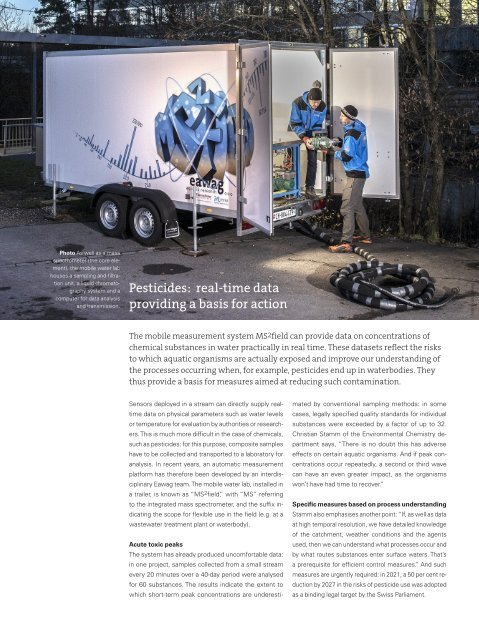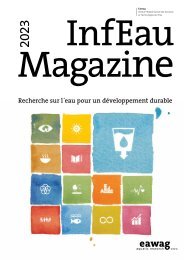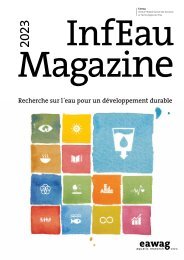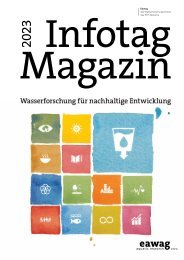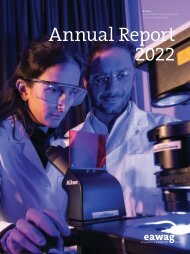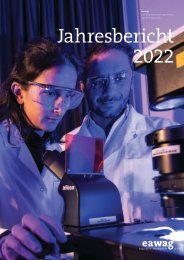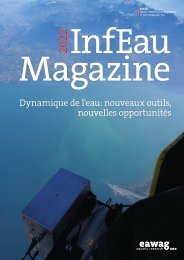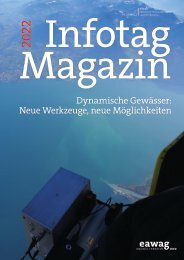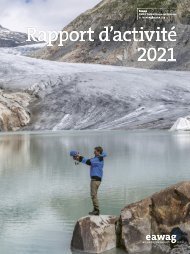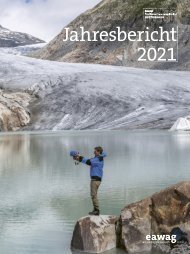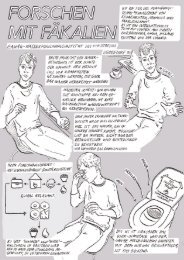Eawag Annual Report 2021
The Annual Report gives a wide-ranging account of current Eawag projects. It is published in English and German, and since 2013 also in French.
The Annual Report gives a wide-ranging account of current Eawag projects. It is published in English and German, and since 2013 also in French.
You also want an ePaper? Increase the reach of your titles
YUMPU automatically turns print PDFs into web optimized ePapers that Google loves.
FORSCHEN<br />
17<br />
Photo As well as a mass<br />
spectrometer (the core element),<br />
the mobile water lab<br />
houses a sampling and filtration<br />
unit, a liquid chromatography<br />
system and a<br />
computer for data analysis<br />
and transmission.<br />
Pesticides: real-time data<br />
providing a basis for action<br />
Aldo Todaro,<strong>Eawag</strong><br />
The mobile measurement system MS2field can provide data on concentrations of<br />
chemical substances in water practically in real time. These datasets reflect the risks<br />
to which aquatic organisms are actually exposed and improve our understanding of<br />
the processes occurring when, for example, pesticides end up in waterbodies. They<br />
thus provide a basis for measures aimed at reducing such contamination.<br />
Sensors deployed in a stream can directly supply realtime<br />
data on physical parameters such as water levels<br />
or temperature for evaluation by authorities or researchers.<br />
This is much more difficult in the case of chemicals,<br />
such as pesticides: for this purpose, composite samples<br />
have to be collected and transported to a laboratory for<br />
analysis. In recent years, an automatic measurement<br />
platform has therefore been developed by an interdisciplinary<br />
<strong>Eawag</strong> team. The mobile water lab, installed in<br />
a trailer, is known as “MS 2 field,” with “MS” referring<br />
to the integrated mass spectrometer, and the suffix indicating<br />
the scope for flexible use in the field (e.g. at a<br />
wastewater treatment plant or waterbody).<br />
Acute toxic peaks<br />
The system has already produced uncomfortable data:<br />
in one project, samples collected from a small stream<br />
every 20 minutes over a 40-day period were analysed<br />
for 60 substances. The results indicate the extent to<br />
which short-term peak concentrations are underestimated<br />
by conventional sampling methods: in some<br />
cases, legally specified quality standards for individual<br />
substances were exceeded by a factor of up to 32.<br />
Christian Stamm of the Environmental Chemistry department<br />
says, “There is no doubt this has adverse<br />
effects on certain aquatic organisms. And if peak concentrations<br />
occur repeatedly, a second or third wave<br />
can have an even greater impact, as the organisms<br />
won’t have had time to recover.”<br />
Specific measures based on process understanding<br />
Stamm also emphasises another point: “If, as well as data<br />
at high temporal resolution, we have detailed knowledge<br />
of the catchment, weather conditions and the agents<br />
used, then we can understand what processes occur and<br />
by what routes substances enter surface waters. That’s<br />
a prerequisite for efficient control measures.” And such<br />
measures are urgently required: in <strong>2021</strong>, a 50 per cent reduction<br />
by 2027 in the risks of pesticide use was adopted<br />
as a binding legal target by the Swiss Parliament.


